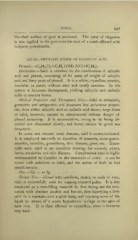Page 545 - My FlipBook
P. 545
SALOL. 543
blanched surface of gum is produced. The spray of rhigolene
is also applied to the gum over the root of a tooth affected with
incipient periodontitis.
SALOL—PHENYLIC ETHER OF SALICYLIC ACID.
Formula.—C,,U,,0^=C,H^ (OH) (CO.OQH^).
Derivation.—Salol is obtained by the combination of salicylic
acid and phenol, consisting of 60 parts of weight of salicylic
acid and forty parts of phenol. It is a white, crystalline powder,
insoluble in water, without odor and nearly tasteless. In the
system it becomes decomposed, yielding salicylic and carbolic
acids in nascent forms.
Medical Properties and Therapeutic Uses.— Salol is antiseptic,
germicide and antipyretic, and possesses less poisonous proper-
ties than either salicylic acid or carbolic acid alone ; large doses
of salol, however, cannot be administered without danger of
phenol poisoning. It is accumulative, owing to its being ab-
sorbed and eliminated slowly, and hence cannot be given too
frequently.
In acute and chronic renal diseases, salol is contra-indicated.
It is employed internally in disorders of stomach, acute gastro-
enteritis, tonsilitis, gonorrhoea, skin diseases, gleet, etc. Exter-
nally used, salol is an excellent dressing for wounds, ulcers,
burns, erysipelas and skin diseases. Camphorated salol is highly
recommended by Cuirllier in the treatment of otitis. It can be
mixed with iodoform or iodol, and the action of both be had
simultaneously.
Dose.— Gr. v. to 5j'
Dental Uses.—Mixed with iodoform, aristol, or oxide of zinc,
salol is successfully used for capping exposed pulps. It is also
employed as a root-filling material by first drying out the root-
canals with absolute alcohol and hot-air, then liquefying a little
salol in a test-tube over a spirit lamp, and injecting some of the
liquid by means of a warm hvpodermic syringe to the apex of
each root. It is then allowed to crystallize, when it becomes
very hard.


